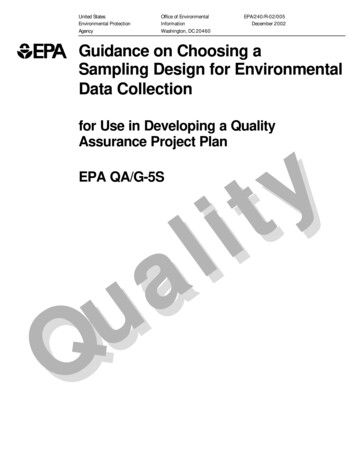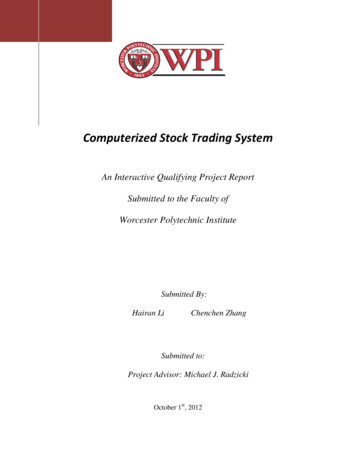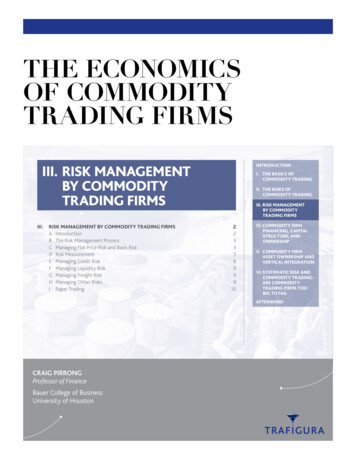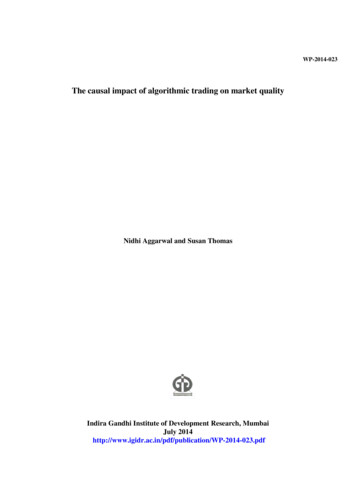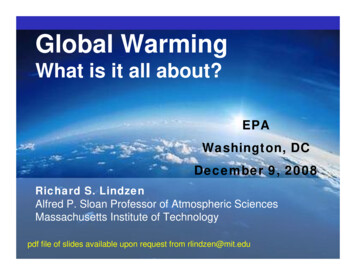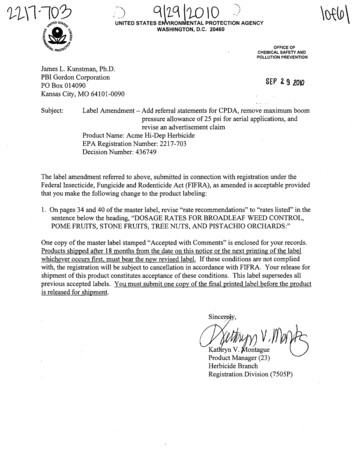
Transcription
October 2008EPAWater Quality TradingEvaluationFinal ReportPromoting Environmental ResultsThrough Evaluation
Page Left Blank Intentionally
TABLE OF CONTENTSE XECUTIVE SUMMA RYC HA P TER 1 I N TR O DU C T I O NBackground on EPA’s Involvement in Water Quality TradingUSDA Programs Related to WQT 1-51-2C HA P TER 2 ME T HO DSEvaluation Questions 2-1Study Design 2-2Program Selection 2-5Quality Assurance ProceduresFinal Report Availability 2-102-10C HA P TER 3 F I N D I NGSStakeholder Perspectives on Trading 3-1Achievements to Date (Evaluation Questions 3 and 4)Barriers to WQT (Evaluation Question 5) 3-16Promoting Trading in the Future 3-213-10C HA P TER 4 RE COMME NDAT IONSRecommendation 1: Recast Water Quality Trading as One Option Within a Suite ofInnovative Permitting Options Supported by EPA 4-2Recommendation 2: Promote Institutional Changes at EPA that WouldSupport Trading 4-3Recommendation 3: Support Trading Only Where Conducive Conditionsare Evident 4-5Recommendation 4: Improve Coordination with USDA to Support Involvement of NonPoint Sources 4-6Recommendation 5: Adjust EPA’s Allocation of Trading Resources 4-7Prioritizing Recommendations 4-8A PP E NDI C IE SAppendix A:Appendix B:Appendix C:Appendix D:List of IntervieweesWater Quality Trading Literature ReviewInterview Guides and Crosswalk with Evaluation QuestionsBibliographyi
ACKNOWLEDGEMENTSThis evaluation was performed by Industrial Economics, Incorporated (IEc) for EPA’sOffice of Policy, Economics and Innovation (OPEI) under Contract EP-W-04-023between EPA and IEc. IEc would like to thank several individuals for their assistance inconducting the Water Quality Trading Evaluation. As the technical advisor, JohnHeffelfinger of OPEI was instrumental in guiding the overall evaluation, and Bob Rose,Chris Lewicki, Ginny Kibler, Kavya Kasturi, and Todd Doley of EPA’s Office of Waterprovided critical coordination assistance and background information. We would also liketo thank the individuals who agreed to be interviewed for this evaluation; Appendix Aprovides a complete list of their professional affiliations.This report was developed under the Program Evaluation Competition, sponsored byOPEI. To access copies of this or other EPA program evaluations, please go to the EPAEvaluation Support Division Website at http:/www.epa.gov/evaluate.ii
EXECUTIVE SUMMARYWater quality trading (WQT) offers a promising approach to controlling pollutants frommultiple sources that collectively impact water quality conditions. In its most simpleform, water quality trading allows one point source to over control for a pollutant at a lowcost, selling the over control as "credits" to another source that is not able to reducepollutants as cost-effectively.Traditionally under the Clean Water Act, controls were focused on reducing pollutantimpacts on local water quality from point sources such as wastewater treatment plants.The impacts of nitrogen, phosphorus and sediment have continued to be pervasive in thenation’s waters. These particular pollutants impact water quality on much larger scalesthan toxic pollutants, whose acute impacts are near the point of discharge. Consequently,nitrogen, phosphorous and sediment can be more effectively addressed by controllingmultiple point and non-point sources of these pollutants within a watershed.The primary potential benefit of WQT that attracts consideration by policy makers is thepotential ability to control pollutants at an overall lower cost to society. In addition,trading that involves non-point sources can have ancillary benefits such as controllingmultiple pollutants and improving the health of aquatic habitats, and trading has thepotential to spur innovation that can further reduce the cost of pollutant controls. Finally,pollution sources not traditionally regulated, most notably non-point pollutants fromagriculture, are the primary source of water quality impairment in many watersheds.WQT provides a framework wherein pollutants can be voluntarily reduced by non-pointsources more cost-effectively than imposing additional treatment controls on pointsources.EPA's Office of Water (OW) fosters WQT through policy development, guidance, andfinancial and technical support to watershed-based trading efforts. EPA has beenundertaking these activities at the headquarters and regional level for over a decade.Despite the theoretical promise of water quality trading and EPA’s efforts, however,WQT to date has met with limited practical success. Only 100 facilities have participatedin trading, and 80 percent of trades have occurred within a single trading program.The purpose of this evaluation is to assess the effectiveness of EPA activities to supportWQT, and to better understand why more water quality trading activity has notoccurred. In consultation with OW, IEc developed 14 detailed evaluation questions toguide the evaluation, which include questions about local/state water quality tradingES-1
programs, the broader context for water quality trading, and the direction of future EPAactivities:Local/state water quality trading program evaluation questions:1. What are stakeholder attitudes towards water quality trading, and why?2. What are the location-specific conditions conducive to water quality trading?3. Have trading programs realized cost savings in meeting permit limits, and if so,how much?4. What outcomes have water quality trading programs achieved?5. What are the educational, institutional, legal, technical, and economic barriers towater quality trading?Broader contextual questions:6. What effects do other federal and state programs, particularly those administeredby the U.S. Department of Agriculture (USDA), have on water quality tradingprograms?7. Do any environmental justice issues arise in the context of water quality trading?If so, how can they be addressed?8. Do any equity issues arise in the context of water quality trading? If so, how canthey be addressed?9. How should EPA measure its own progress on water quality trading?Questions on future EPA activities:10. Would more specific guidance or specific tools from EPA help state and localgovernments foster trading? If so, what kinds of guidance or tools are needed?11. Are there legal, regulatory, or policy questions that impede trading, and if so,what can EPA do to address them?12. What can EPA do to create flexibility and incentives for states to support legaland enforceable water quality trading programs?13. What can EPA do to support water quality trading among point and non-pointsources?14. Have federal or state resources made a difference in establishing tradingprograms, or could they help make a difference?As discussed in Chapter 2 of this report, IEc employed an interview-based approach tocollecting information for this evaluation, using a literature review as a foundation. IEccompleted a total of 55 interviews. Most of the interviews were conducted withindividuals associated with 11 different WQT programs or initiatives. For each waterES-2
quality trading initiative studied, IEc interviewed between three and five individualsrepresenting a variety of perspectives. IEc and EPA selected programs and initiatives tostudy based on a set of criteria including the program's transferability,legality/enforceability, level of success, illustration of barriers, and program maturity. Inaddition to interviewing individuals affiliated with specific water quality tradinginitiatives, IEc also interviewed 14 individuals from agencies and organizations that havea national perspective on water quality trading, including staff from EPA regional offices,USDA, environmental advocacy groups, and other experts.IEc synthesized evaluation findings based on a detailed analysis of the intervieweefeedback as well as on our literature review. We organize findings by evaluationquestion in Chapter 3: We first discuss general stakeholder perspectives on WQT as specified inEvaluation Question 1. Also included are stakeholder views on the conditionsconducive to WQT (Evaluation Question 2) and opinions expressed on the equityand environmental justice implications of WQT (Evaluation Question 7 and 8). The next section describes the achievements of the WQT programs examined inthis evaluation, focusing on environmental achievements; cost savings and othereconomic benefits; participation and trading activity; and other outcomes(Evaluation Questions 3 and 4). The third section describes interviewee perspectives on the barriers to WQT(Evaluation Question 5). The final section reviews interviewee suggestions for how EPA could supportWQT in the future. The discussion covers regulatory, legal, and administrativeissues that EPA can help address (Evaluation Questions 11 and 12); suggestionsfor future tools and financial support (Evaluations Questions 10 and 14);approaches to promoting the participation of non-point sources (EvaluationQuestion 6 and 13); and options for EPA to better measure progress of WQTprograms (Evaluation Question 9).As presented in Chapter 4, IEc has developed five main recommendations for EPA toconsider when planning future Agency efforts to support WQT. We base theserecommendations on our synthesis of interviewee feedback and our understanding of thehistory and implementation experience of WQT to date. These recommendations do notfocus on the numerous barriers to WQT that EPA cannot address, such as statutoryambiguity, narrow circumstances conducive to trading, and the lack of a generic tradingmodel applicable to most locations. Instead, the recommendations focus on the smallerset of barriers that are within EPA's purview to address. The main recommendations areas follows:ES-3
1. Recast water quality trading as one option within a suite of innovative permittingoptions supported by EPA.2. Promote institutional changes at EPA that would support trading, includingclarifying legal issues, changing EPA guidance, and developing andimplementing strategies to move EPA and state environmental agency culturetowards greater knowledge and acceptance of WQT.3. Support trading only where conducive regulatory, economic, hydrologic, andgeographic conditions are evident, and by requiring screening assessments as acondition of EPA funding for WQT programs.4. Improve coordination with USDA to support involvement of non-point sources,including coordination on technical tools and approaches.5. Adjust EPA's allocation of trading resources, including establishing a technicalsupport team to provide on-site, hands-on assistance to nascent or strugglingtrading initiatives; restoring small and nimble grant funding for WQT programs;and investing in replicating the success of the Long Island Sound program.ES-4
CHAPTER 1 INTRODUCTIONWater quality trading (WQT) offers a promising approach to controlling pollutants frommultiple sources that collectively impact water quality conditions. Traditionally underthe Clean Water Act, controls were mostly focused on pollutants with local impact fromparticular point sources, such as wastewater plants. As the focus of efforts to protectwater quality has shifted to include pollutants whose collective impact is felt downstream,it is not always necessary or cost-effective to control pollutants at specific locations.Alternatively, some pollutants can be controlled across multiple sources within awatershed; nitrogen, phosphorus, and sediment are the three pollutants EPA mostcommonly recognizes as having such potential.The primary potential benefit of WQT that attracts consideration by policy makers is thepotential ability to control pollutants at an overall lower cost to society. In its mostsimple form of point-to-point trading, water quality trading allows one point source toover control for a pollutant at a low cost, selling the over control as "credits" to anotherpoint source that is not able to reduce pollutants as cost-effectively. Through the trade,the second point source can achieve its share of responsibility at a lower cost, the firstpoint source can recoup part of its costs, local water quality is not negatively impacted,and downstream water quality is improved. Other potential benefits of greater flexibilityinclude the ability to better plan capital intensive upgrades, and better time such upgradeswithin existing financial options (such as retirement of previous debt obligations prior toincurring new debt obligations).A less tangible but no less real benefit of water quality trading is the increased incentivefor innovation. Even if a point source purchases “credits,” the water quality tradingprogram creates incentives for the point source to find low-cost ways to reduce pollutants,to reduce the need to purchase credits. At the same time, a point source selling suchcredits has added incentive to maintain the performance of their pollutant controls sincedoing so translates into more credits for sale. Both incentives work in balance to achievethe needed reduction of a pollutant at the overall lowest cost to society, and for all partiesinvolved.Finally, pollutant sources not traditionally regulated, most notably non-point pollutantsfrom agriculture, are the primary source of water quality impairment in many watersheds.WQT provides a framework wherein pollutants can be voluntarily reduced by farmers forthe purpose of selling credits. As such, WQT is one of few current tools that EPA has toaddress unregulated discharges.1-1
B A C K G R O U N D O N E PA’ S I N V O LV E M E N T I N WAT E R Q U A L I T Y T R A D I N GEPA's Office of Water (OW) fosters water quality trading through policy development,tools and guidance, and financial and technical support to watershed-based tradingefforts. Key activities include: Policy development: EPA developed a water quality trading policy tocommunicate the Agency's official position supporting trading a number ofyears ago, and most recently updated the policy in 2003. EPA also reviewsand provides advice on state and local trading frameworks. Tools and Guidance: EPA has developed several tools and guidancedocuments to assist states and local governments in developing robust tradingprograms. Most recently, EPA developed the Water Quality Trading Toolkitfor Permit Writers, a comprehensive "how to" manual on designing andimplementing WQT programs. The Toolkit also contains fact sheets thatprovide detailed information on current trading programs. Other toolssupported by EPA including the Water Quality Trading AssessmentHandbook and Getting Paid for Stewardship guide, as well as severalcommunication materials (e.g., fact sheets, newsletters, website content). Training: EPA developed a training course on WQT and holds the course forindividuals involved in trading efforts on a regular basis. The courseprovides an introduction to trading as well as specific modules on the CleanWater Act and trading, types of trading, assessing the financial feasibility oftrading, and designing a credible trading program. EPA also providesseparate training sessions for permit writers. Financial Support: EPA provides grant assistance to trading programs at thestate and local level. One of the key EPA funding sources for WQT is theTargeted Watershed Grants Program, a portion of which has supportedtrading efforts.EPA has been undertaking activities to support WQT at the Headquarters and regionallevel for over a decade. As a result of EPA, state, and local efforts, over 25 WQTprograms have been launched.Despite the theoretical promise of water quality trading and EPA’s efforts, however,water quality trading to date has met with limited practical success. Only 100 facilitieshave participated in trading, and 80 percent of trades have occurred within a singletrading program (Long Island Sound). Moreover, relatively few trading programs havebeen scaled up from pilot projects to permanent programs, and even fewer can claim tohave had a significant impact in improving water quality or reducing pollutant controlcosts.The purpose of this evaluation is to assess the effectiveness of the WQT Program and tobetter understand why more water quality trading activity has not occurred. The findingsand recommendations of this evaluation will help identify opportunities for improving1-2
EPA efforts to foster water quality trading and related permitting innovations. Theevaluation will also inform the development of effective state trading policies and willhelp build OW’s capacity to assist state partners in evaluating local water quality tradingprograms.The remainder of this introductory chapter presents EPA’s involvement in water qualitytrading with a logic model, and also discusses USDA programs related to WQT.Subsequent chapters of the report are organized as follows: Chapter 2 presents the methodology used in this evaluation. Specifically, IEcpresents the Evaluation Questions, study design, and program selection process. Chapter 3 presents the evaluation findings based on information collected throughinterviews and literature review. Chapter 4 presents IEc's recommendations for moving forward based on oursynthesis of findings.Appendices A, B, C, and D include, respectively, a list of the individuals interviewed forthis evaluation (position and affiliation only), a summary of a comprehensive review ofboth published and unpublished water quality trading literature, the interview guides usedfor various stakeholder groups with a crosswalk of evaluation and interview questions,and a bibliography of resources consulted for this evaluation.Wa t e r Q u a l i t y Tra d i n g P r o g ra m L o g i c M o d e lTo illustrate the various components of EPA WQT activities and to inform developmentof specific evaluation questions, EPA has developed a logic model (i.e., a graphicalrepresentation of the relationships between program inputs, outputs, and intendedoutcomes). As shown in Exhibit 1, the key components of the model include:1-3
E X H I B I T 1 : E PA WAT E R Q U A L I T Y T R A D I N G L O G I C M O D E L1-4
Resources are the basic inputs of funds, staffing, and knowledge dedicated to theprogram. Partners are the other agencies and organizations that contribute toward sharedprogram goals. WQT Program partners include USDA/Natural ResourcesConservation Service (NRCS) and non-governmental organizations (NGOs) thatsupport water quality trading. Activities are the specific procedures or processes used to achieve program goals.For example, WQT Program activities include policy development, education andoutreach. Outputs are the immediate products that result from activities and are often usedto measure short-term progress. For example, EPA outputs include the 2003Water Quality Trading Policy, trading brochures, newsletters and nationalconferences. Customers are the groups and individuals targeted by WQT Program activitiesand outputs. For example, EPA provides outreach to local trading programchampions, Total Maximum Daily Load (TMDL) developers, and permit writersto educate them about the design and implementation of water quality tradingprograms. Short-Term Outcomes are the changes in awareness, attitudes, understanding,knowledge, and skills resulting from program outputs that are causally linked tothe WQT Program. For example, technical guides, EPA's published water qualitytrading policy, and the Water Quality Trading Handbook provided to state policywriters and TMDL developers increase understanding of the design of waterquality trading programs. Intermediate Outcomes are the changes in behavior that are broader in scopethan short-term outcomes. Intermediate outcomes often build upon the progressachieved in the short-term. For example, increased understanding of the design ofwater quality trading programs results in States developing trading frameworks,and TMDL developers adopting TMDLs that embrace water quality trading. Long-Term Outcomes are the overarching goals of the program, which in thiscase include attainment of water quality standards in a more cost-effective andefficient manner.U S D A P R O G R A M S R E L AT E D TO W Q TUSDA's NRCS administers several programs that fund best management practice (BMP)installation and conservation practices at farms, and provide associated technicalassistance to farmers. Many of the conservation practices supported by USDA can alsogenerate non-point source credits under water quality trading programs.1-5
USDA conservation programs have a long history. The initial focus of the programs wasto reduce soil erosion and improve soil health. The 1985 Farm Bill established the first ofthese programs, the Conservation Reserve Program, which pays farmers for conservingsensitive cropland. The 1990 Farm Bill created the Wetlands Reserve Program, and theWater Quality Incentives Program, which was the first time that the Farm Bill linkedconservation programs to water quality. The 1996 bill created the Environmental QualityIncentives Program (EQIP), which provides cost sharing for BMPs. The 2002 Farm Billgreatly expanded funding for all of the above programs and created some additional subprograms. Most relevant to water quality, the 2002 bill established the ConservationSecurity Program (CSP) and the Conservation Innovation Grants (CIG) program underEQIP. CSP provides incremental financial incentives to farmers for long-term landstewardship. CIG provides grant funding to state and local governments and NGOs fordemonstrating and testing innovative approaches to conservation and stewardship. Todate, CIG has funded approximately 10 projects, one of them being a project included inthe Great Miami WQT program studied in this evaluation.Most USDA conservation programs are now designed to yield multiple environmentalbenefits (e.g., water quality, soil management, and habitat preservation), but a USDAanalysis of individual project funding indicates that some programs are geared more toaddressing water quality issues than others. In particular, the EQIP, ConservationSecurity Program, and Conservation Reserve Program have significantly more fundingdedicated to water quality concerns than other programs, (between 32-50% of fundingand technical assistance is focused on water quality, compared with less than 15% forother programs).1Funding for USDA conservation programs has increased significantly, fromapproximately 3 billion in 1990 to 5.6 billion in 2005. Funding for the EQIP programalone ranges from 200 million in 1996, its initial year, to an estimated 1.3 billion in2007.2 In 2004, fifteen percent of all U.S. farms received a conservation payment fromUSDA.3A new farm bill is currently under consideration in Congress. The Administration'sproposal includes a 500 million increase to the Conservation Security Program over 10years, and a 4.25 billion increase to the EQIP program. The Administration's proposalwould also add a new EQIP subprogram called the regional Water Enhancement Programto fund water quality and conservation projects.4 The current version of the farm billmoving through Congress contains this new subprogram.1USDA, 2007 Farm Bill Theme Papers, Conservation and the Environment, June 2006, p. .pdf23CRS Report for Congress, Previewing a 2006 Farm Bill, January 30, 2006, p. 18.USDA, 2007 Farm Bill Theme Papers, Conservation and Environment, June 2006, p. nv.pdf4Letter from Mike Johans, former USDA Secretary, to Tom Harkin, Senate Chair of the Senate Agriculture, Nutrition, andForestry Committee, April 25, 2007: -6
The current version of the farm bill also contains a provision to establish a standardsboard relevant to water quality trading and other markets for ecosystem services. Thepurpose of this board is to "develop uniform standards for quantifying environmentalbenefits, establish reporting and credit registries, and promote actions that facilitate thedevelopment and functioning of environmental services markets involving agricultureand forestry."5 USDA, EPA, and five other agencies would be represented on the board;the President is charged with designating a chair to oversee it.In addition to the above programs, NRCS works directly to support water quality tradingamong non-point sources through tool development and outreach efforts. NRCS workedwith EPA to develop a nitrogen modeling tool to estimate reductions from BMPs; theNitrogen Trading Tool (NTT) prototype is currently being tested in Ohio, Maryland, andColorado. USDA made significant contributions to Getting Paid for Stewardship, a guideto water quality trading for non-point sources. Currently, USDA is developing ahandbook for NRCS field staff and partners to explain and support various types oftrading, including water quality trading, wetlands trading, and carbon offsets. USDA alsocosponsors water quality trading conferences and workshops in conjunction with EPA.52007 Farm Bill Proposals, Title II: Conservation, Subtitle J: Market-Based Approaches to rvation 071.pdf1-7
CHAPTER 2 METHODSThis chapter discusses the methodology employed to evaluate EPA’s water qualitytrading efforts. First, we present the questions that the evaluation sought to answer,followed by a discussion of the study's design. We then describe the processes ofselecting specific trading programs to evaluate. Finally, we describe our qualityassurance procedures and provide information on the availability of the final report.E VA L U AT I O N Q U E S T I O N SIEc developed 14 detailed Evaluation Questions to guide the evaluation, which includequestions about local/state water quality trading programs, the broader context for waterquality trading, and the direction of future EPA activities.Local/state trading program questions:1. What are stakeholder attitudes towards water quality trading, and why?2. What are the location-specific conditions conducive to water quality trading?3. Have trading programs realized cost savings in meeting permit limits, and if so,how much?4. What outcomes have water quality trading programs achieved?5. What are the educational, institutional, legal, technical, and economic barriers towater quality trading?Broader contextual questions:6. What effects do other federal and state programs, particularly those administeredby USDA, have on water quality trading programs?7. Do any environmental justice issues arise in the context of water quality trading?If so, how can they be addressed?8. Do any equity issues arise in the context of water quality trading? If so, how canthey be addressed?9. How should EPA measure its own progress on water quality trading?2-1
Questions on future EPA activities:10. Would more specific guidance or specific tools from EPA help state and localgovernments foster trading? If so, what kinds of guidance or tools are needed?11. Are there legal, regulatory, or policy questions that impede trading, and if so,what can EPA do to address them?12. What can EPA do to create flexibility and incentives for states to support legaland enforceable water quality trading programs?13. What can EPA do to support water quality trading among point and non-pointsources?14. Have federal or state resources made a difference in establishing tradingprograms, or could they help make a difference?STUDY DESIGNIEc employed an interview-based approach to collecting information for this evaluation,using a literature review as a foundation.L i t e ra t u r e R e v i e wIEc conducted a comprehensive review of both published and unpublished informationrelated to water quality trading in the U.S. The literature review consisted of three distinctsteps.IEc first, conducted a preliminary review of key resources on water quality trading todevelop a baseline understanding of trading activity to date, key issues and barriers intrading, and trading program models. Appendix B presents the sources identified in thisreview and the key findings associated with each source.Second, IEc reviewed key EPA WQT documents including the National Water QualityTrading Handbook, the Water Quality Trading Toolkit for Permit Writers, and GettingPaid for Stewardship: An Agricultural Community Water Quality Trading Guide.Finally, IEc reviewed literature and available information associated with specific tradinginitiatives. This review identified approximately 25 active and inactive water qualitytrading programs in the U.S., most of which involve trading between point and non-pointsources and focus on control of nutrients and sediments. IEc collected information oneach program’s target pollutants, activity level, and structure.2-2
Collect And Analyze Data From Interv iewsExisting data and literature were insufficient to address the Evaluation Questions.Consequently, it was necessary to conduct primary data collection. IEc and EPA agreedon an interview-based approach to data collection for this evaluation. Specificconsiderations favoring an interview-based approach to data collection include thefollowing: The issues of interest cannot easily be addressed by multiple-choice or shortanswer questions typically used in surveys. The evaluation involves a relatively large set of questions that will take mostparticipants a half hour or more to answer. The topics to be addressed are highly intertwined, and responses are likely tobridge multiple questions. Some Evaluation Questions address sensitive topics (e.g., unsuccessful tradinginitiatives and competition for resources). Customizing questions for different groups would be beneficial.IEc and EPA decided to conduct individual interviews instead of group interviews orfocus groups. Focus groups work well when respondents can be categorized into a verysmall number of homogeneous groups. In contrast, for the water quality tradingevaluation, we were interested in talking to several different groups of stakeholders.Moreover, stakeholders that share exp
1. Recast water quality trading as one option within a suite of innovative permitting options supported by EPA. 2. Promote institutional changes at EPA that would support trading, including clarifying legal issues, changing EPA guidance, and developing and implementing strategies to move EPA and state environmental agency culture
